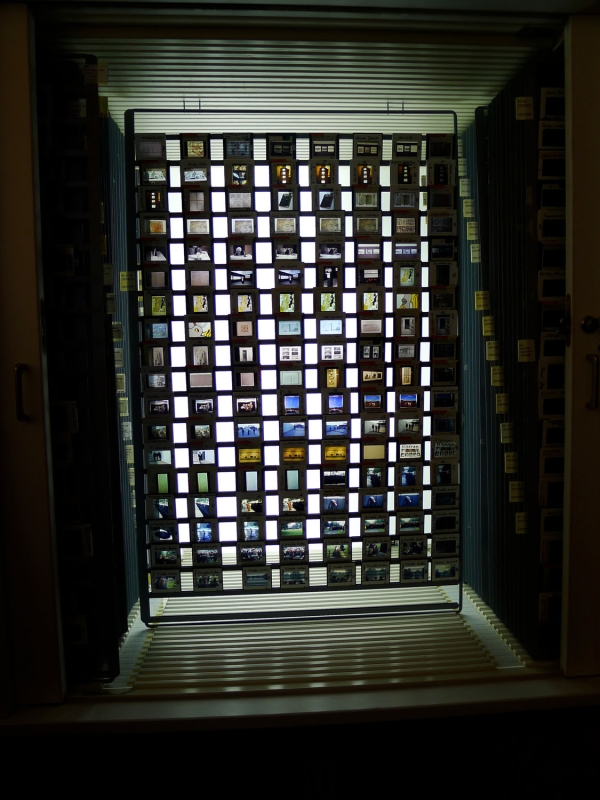Elective Affinities
Elective Affinities
26 February – 29 March 2013
In: “The End(s) of the Library”
30 October 2012 – 21 June 2013
Goethe-Institut New York Library
With Julieta Aranda; Fia Backström & R. Lyon; David Horvitz; Christian Philipp Müller; and The Serving Library
Curated by Jenny Jaskey
In June of 1997, Christian Philipp Müller set out for the Friedrichsplatz in Kassel to trace a path between two extant icons of documenta’s past: Walter de Maria’s “The Vertical Earth Kilometer” and the first and last trees planted for Joseph Beuys’ “7,000 Oaks.” In the years since these site-specific interventions were first rooted in the soil of the plaza’s center, new construction eventually shifted the physical relationship envisaged by the artists between their “eternal” works and the city of Kassel. Müller’s performance and subsequent museum installation for documenta X, called “A Balancing Act,” marked these changes, while contemplated the status of the public works from the retro-perspective of their impending obsolescence. As George Baker pointed out in his essay for the work, “It is only with...the ruination of an institution, the break-up of a cultural formation...that its history becomes visible for the first time.”[1]
For his current exhibition “Elective Affinities” at the Goethe-Institut New York, Müller returns to the annals of art history, this time delicately balancing its archival materials across continents and institutions. Drawing his selections from the documenta-Archive in Kassel, as well as the Harald Szeemann archive recently acquired by The Getty Research Institute in Los Angeles, Müller crisscrosses historical documents of artistic and diplomatic exchange, while making possible new institutional collaborations in the present.
The exhibition begins with a single vitrine, whose form suggests the slim lines of a sarcophagus. Two massive metal and copper walking sticks given to documenta’s founder Arnold Bode by his great admirer and quintessential documenta artist, Joseph Beuys. According to his widow, Bode received the sticks on his 75th birthday and cherished them until his death two years later, the day after documenta 6 closed on October 3, 1977. The medal of honor Bode received from the President of the Federal Republic of Germany, Theodor Heuss, in 1959 sits between Beuys’ gifts.
Müller’s presentation continues in the Goethe library’s galley with a selection of rare archival materials variously drawn from documenta 5 (1972), curated by Harald Szeemann, and documenta 6 (1977), curated by Manfred Schneckenburger. Artists’ correspondence with these curators — including letters from Richard Artschwager, Michael Asher, Vito Acconci, Hans Haacke, and Robert Smithson, among others — make visible the sometimes contentious planning processes behind the first year that documenta hired a single artistic director. Müller’s selections from 1977 include proposals from Marina Abramović, Laurie Anderson, Alice Aycock, Joan Jonas, Maria Nordman, and Gina Pane. These letters and photographs emphasize the increasing presence of new media, video and performance at the end of the 1970s, along with the institutional changes provoked by these emerging formats.
The theme of obsolescence so crucial to a materialist dialectic appears throughout the exhibition, and its most timely occurrence may be Müller’s engagement with analog archival materials like black and white prints and color slides that have been recently transformed to digital media. On a looping slideshow flanking his letter-filled vitrines, Müller presents over 2,400 digitized images of documenta 5 drawn from the Harald Szeemann archives at The Getty Research Institute on a looping slideshow, along with a second video whose content is derived from the remaining analog slides of documenta 5 and 6 stored at the documenta-Archive. The selections are the outcome of a set of search terms the artist gave both institutions when doing his research and correspond to the artists whose physical documents are on view. The available images vary widely by artist and exhibition, and they are presented in the precise order in which Müller received them. Completing this meditation on new and aging technologies, the artist has made a new print that performs as the exhibition’s signage, referencing both digital and letterpress techniques. Likewise, scanned facsimiles of an archived copy of the artist’s flyer for A Balancing Act at documenta X are available free of charge as the exhibition’s take-away publication.
“Elective Affinities” continues Müller’s context-based approach to art making, as well as his investigations into the self-image of national identity. Works including “Grüne Grenze” (Green Border) for the 45th Venice Biennial and “Histories in Conflict: Haus der Kunst and the Ideological Uses of Art” (2012–2013) share his current project’s interest in the conditions of representation from the vantage point of the archive. His exhibition for the Goethe-Institut responds to the shared ambitions of the Goethe-Institut Library and documenta — to reconcile German public life with international modernity by encouraging international cultural exchange — and in so doing, proposes a set of “elective affinities” between the two institutions, as well as a meditation on art’s diplomatic function and its inherent relationship to the politics of exchange.
“Elective Affinities” is the third in a series of artist commissions for “The End(s) of the Library,” a project curated by Jenny Jaskey on behalf of the Goethe-Institut New York Library. These exhibitions and special events, taking place from October 2012 to June 2013, invite artists to reflect on the potential of libraries, using the Goethe-Institut New York Library as a primary site of these inquiries.
Footnotes
- George Baker and Christian Philipp Müller, “A Balancing Act,” in October 82 (Fall 1997), pp. 94-118.
Text by Jenny Jaskey




